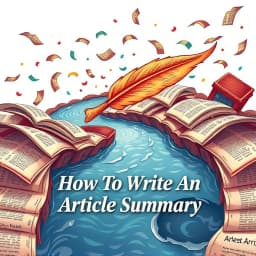
How to Write an Article Summary
Find this useful? Bookmark ( CTRL/CMD + D ) for quick access!
Try an example:
Academic Research Summary
Blog Post Recap
News Article Digest
Book Chapter Overview
Product Review Summary
Conference Paper Abstract
Explore Similar Tools
Recent Generations
the amount paid directly to you. Yes it is possible in future cases to request direct payment to the provider, Rephrase and give me polished email.
we have processed the claim as per the attachments in the claim submission we have processedthe invoice for Saul Holding. We dont have invoice for the Salofalk.
this additional information is very important. this adiitional information was requested by our clinical team. Without clinical review claim not be paid so please share the below additional information
How To Write An Article Summary
How To Write An Article Summary is a powerful AI-powered tool that helps users create concise and effective summaries of articles. This innovative solution combines advanced natural language processing with user-friendly features to deliver high-quality summaries that capture the essence of any text.
Key Capabilities
- Automated Summarization with advanced algorithms that distill lengthy articles into key points, saving you time and effort.
- Customizable Summary Length enabling users to choose between brief overviews or detailed summaries, tailored to their specific needs.
- Contextual Understanding for accurate representation of the original article's themes and arguments, ensuring that important information is not lost.
- User-Friendly Interface that allows anyone, regardless of technical skill, to generate summaries quickly and efficiently.
Who It's For
Designed for students, researchers, and professionals, How To Write An Article Summary excels in academic and business environments. Whether you're preparing for a presentation or conducting literature reviews, this tool streamlines your workflow and enhances productivity.
Why Choose How To Write An Article Summary
What sets How To Write An Article Summary apart is its ability to maintain the integrity of the original content while providing a clear and concise summary, making it the ideal solution for anyone looking to grasp complex information quickly.
Ready to transform your article summarization process? Start using How To Write An Article Summary today and experience the difference!
Enhance Your Work with How to Write an Article Summary
Leverage the power of AI to streamline your tasks with our How to Write an Article Summary tool.
Concise Summarization
Effortlessly condense lengthy articles into clear and concise summaries, capturing the main ideas.
Customizable Output
Tailor the summary length and style to meet your specific needs, ensuring relevance and clarity.
Source Integration
Seamlessly integrate with various sources and formats, making it easy to summarize articles from multiple platforms.
How How to Write an Article Summary Works
Discover the simple process of using How to Write an Article Summary to improve your workflow:
Input Article
Paste or upload the article you want to summarize into the tool.
Set Summary Preferences
Choose the length and style of the summary you desire for your article.
AI Summarization
The AI processes the article and generates a concise summary based on your preferences.
Review and Edit
Examine the summary and make any necessary edits before finalizing.
Use Cases of
How to Write an Article Summary
Explore the various applications of How to Write an Article Summary in different scenarios:
Academic Research
Summarize lengthy academic articles to quickly grasp key findings and methodologies, aiding in literature reviews and research projects.
Content Creation
Generate concise summaries of articles to create engaging content for blogs or social media, helping to attract and inform readers.
Business Reports
Condense industry reports and white papers into brief summaries for executives, facilitating informed decision-making without overwhelming detail.
Study Aids
Create summaries of educational materials for students, enhancing comprehension and retention of information for exam preparation.
Who Benefits from How to Write an Article Summary?
AI-Powered Efficiency
From individuals to large organizations, see who can leverage How to Write an Article Summary for improved productivity:
Students
Summarize academic articles and research papers to enhance understanding and retention.
Content Creators
Quickly distill information from various sources to create engaging content.
Researchers
Efficiently summarize findings from multiple studies to support their work.
Educators
Create concise summaries of educational materials to facilitate learning.
Frequently Asked Questions
What is the purpose of the 'How To Write An Article Summary' AI tool?
The tool is designed to help users quickly and effectively summarize articles by extracting key points and main ideas, making it easier to understand and retain information.
How does the AI generate article summaries?
The AI uses natural language processing algorithms to analyze the text, identify important concepts, and condense the content into a coherent summary while maintaining the original meaning.
Can the tool summarize articles in different languages?
Yes, the AI tool supports multiple languages and can summarize articles written in various languages, although the accuracy may vary depending on the language and complexity of the text.
Is there a limit to the length of articles I can summarize?
While there is no strict limit, extremely long articles may take longer to process, and the quality of the summary may depend on the complexity and structure of the text.
Can I customize the summary length or style?
Yes, users can specify their preferred summary length and style, allowing for tailored outputs that meet specific needs, whether for academic, professional, or personal use.
































